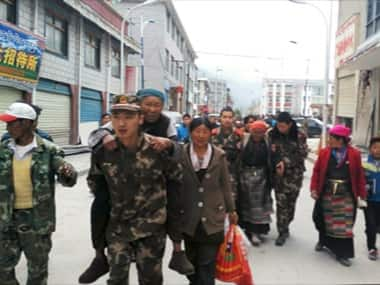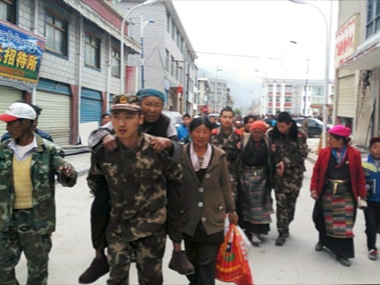What has prompted the people of earthquake-hit Nepal to flock to Twitter with their #GoHomeIndianMedia onslaught? Is their annoyance over India’s big-brotherly attitude, who is staking disproportionate claim for the rescue operations, or the blatant misuse of a tragedy by its ruling party proxies to earn publicity for the country’s Prime Minister? Or is it really an exasperated reaction of a country that is hurt by the insensitive on-screen excesses by Indian media? [caption id=“attachment_2226848” align=“alignleft” width=“380” class=" “]
 Image used for representational purpose only. Reuters[/caption]
Reports from Kathmandu
indicate that the 60,000 tweets with this hashtag comprise all these emotions and more. People in Nepal are reportedly very annoyed and want Indians out while the latter play valiant saviour. In fact, Prime Minister Modi had even claimed that his Nepali counterpart learnt about the earthquake only from his tweet. It’s true that a lot of Indians, probably the Sangh and BJP proxies, have been flooding the social media with propaganda messages hailing Modi and the Indian armed forces as the heroes of the rescue operations in Nepal even as other countries and multilateral agencies are responding to the tragedy with equal vigour. In fact, it was not India that signed the first cheque to Nepal after the earthquake, but Bhutan which contributed $1 million. Asian Development Bank followed it up with a donation of $3 million. While Indian media hailed the response of its rescue efforts, what it failed to report was the promptness of others. For instance, The Dutch government sent a team with 62 specialists and eight dogs while UNOCHA, the UN agency for coordination of humanitarian assistance, also pressed its experts into service. Many multilateral and bilateral organisations have huddled together with Nepalese officials in Kathmandu to respond to the emergency. However, Indians as a whole shouldn’t worry about Nepal’s fit of pique because it’s an existential issue for the landlocked country that’s forever feeling patronised by a big brother. And big brother India does flourish at the opportunities like the earthquake to flex its muscles and indulge in its super power fantasies. It had done it with Maldives (cracking down of a mercenary-led coup attempt), Sri Lanka (the infamous IPKF intervention) and even Bangladesh (Farakka waters). But with Nepal, it happens too often because its economy owes its survival to India, which does betray an attitude of dominance. And every time India shows this attitude, Nepalese recoil and react. In 1999, when an Indian Airlines aircraft was hijacked by Taliban terrorists who boarded the plane with a lot of arms from Kathmandu airport, Indian media made Nepal look like a lawless Somalia. Although satellite TV was still in its nascency, the then high-grossing Hindi news channel sensationalised the Nepali involvement to such levels that it described a Nepali businessman as an accomplice of the hijackers and broadcast his pictures. Indian print media competed with one another to do features, mostly with the same inputs from intelligence agencies, that presented Nepal as a haven for ISI’s anti-India operations. Those days, any Indian visitor to Kathmandu was met with an indignant Nepali. A year later, the anger erupted into violence when actor Hrithik Roshan was misquoted on TV as saying he hated Nepal and its people. This time, they attacked Indians and their businesses. The healing took a lot of effort and time. Nepali politicians have always been suspicious of India and its intent and have used it to whip up useful nationalism. Funnily enough, before joining mainstream politics, Maoist leader and former Prime Minister Prachanda had warned his insurgent army of an Indian invasion and asked them to dig tunnels and bunkers in preparation. Despite the thaw in his relationship with the Indian establishment, he raked up the bogey of Indian dominance even recently when he said that India wanted to interfere with the micromanagement of Nepal. The problem is Nepal’s economic dependence on India and the pressure on its cultural identity. Besides offering jobs and opportunities for higher education for Nepalese citizens, India is also its biggest trade partner and inadvertent cultural coloniser. In terms of trade, both exports and imports with India have swelled many times over the years. A
study by Nepal’s Central Bank
recommends that the country expand trade with China to reduce the dependence on India. Bollywood and Indian profiteers swarm Kathmandu valley. As in the case of Maldives and Sri Lanka, which try to make their next-door big brother insecure by courting a distant China, Nepal too is playing the China card. Last year, China replaced India as the country’s biggest foreign investor. As this
Bloomberg report
shows, Chinese geo-political influence is spreading faster in Nepal than ever before through trade and investments. Trade with China is booming. What the latest twitter fiasco exposes is India’s inability to understand that nationalism, particularly when one is low on confidence, trumps every other emotion even if Modi reiterates that Nepal’s pain is India’s too. Every time India makes condescending noises, they may hark back to the terrible days of trade blockade by Rajiv Gandhi in 1989. But, Nepal must not forget decades of Indian aid and trade concessions, and its open door for millions of Nepalese job seekers. It doesn’t matter that Modi chose Nepal as his first overseas destination after becoming the prime minister and offered a US $ 1 billion line of credit to fund development. Nepal wants our help, but more than that, it wants to be treated as an equal.
Image used for representational purpose only. Reuters[/caption]
Reports from Kathmandu
indicate that the 60,000 tweets with this hashtag comprise all these emotions and more. People in Nepal are reportedly very annoyed and want Indians out while the latter play valiant saviour. In fact, Prime Minister Modi had even claimed that his Nepali counterpart learnt about the earthquake only from his tweet. It’s true that a lot of Indians, probably the Sangh and BJP proxies, have been flooding the social media with propaganda messages hailing Modi and the Indian armed forces as the heroes of the rescue operations in Nepal even as other countries and multilateral agencies are responding to the tragedy with equal vigour. In fact, it was not India that signed the first cheque to Nepal after the earthquake, but Bhutan which contributed $1 million. Asian Development Bank followed it up with a donation of $3 million. While Indian media hailed the response of its rescue efforts, what it failed to report was the promptness of others. For instance, The Dutch government sent a team with 62 specialists and eight dogs while UNOCHA, the UN agency for coordination of humanitarian assistance, also pressed its experts into service. Many multilateral and bilateral organisations have huddled together with Nepalese officials in Kathmandu to respond to the emergency. However, Indians as a whole shouldn’t worry about Nepal’s fit of pique because it’s an existential issue for the landlocked country that’s forever feeling patronised by a big brother. And big brother India does flourish at the opportunities like the earthquake to flex its muscles and indulge in its super power fantasies. It had done it with Maldives (cracking down of a mercenary-led coup attempt), Sri Lanka (the infamous IPKF intervention) and even Bangladesh (Farakka waters). But with Nepal, it happens too often because its economy owes its survival to India, which does betray an attitude of dominance. And every time India shows this attitude, Nepalese recoil and react. In 1999, when an Indian Airlines aircraft was hijacked by Taliban terrorists who boarded the plane with a lot of arms from Kathmandu airport, Indian media made Nepal look like a lawless Somalia. Although satellite TV was still in its nascency, the then high-grossing Hindi news channel sensationalised the Nepali involvement to such levels that it described a Nepali businessman as an accomplice of the hijackers and broadcast his pictures. Indian print media competed with one another to do features, mostly with the same inputs from intelligence agencies, that presented Nepal as a haven for ISI’s anti-India operations. Those days, any Indian visitor to Kathmandu was met with an indignant Nepali. A year later, the anger erupted into violence when actor Hrithik Roshan was misquoted on TV as saying he hated Nepal and its people. This time, they attacked Indians and their businesses. The healing took a lot of effort and time. Nepali politicians have always been suspicious of India and its intent and have used it to whip up useful nationalism. Funnily enough, before joining mainstream politics, Maoist leader and former Prime Minister Prachanda had warned his insurgent army of an Indian invasion and asked them to dig tunnels and bunkers in preparation. Despite the thaw in his relationship with the Indian establishment, he raked up the bogey of Indian dominance even recently when he said that India wanted to interfere with the micromanagement of Nepal. The problem is Nepal’s economic dependence on India and the pressure on its cultural identity. Besides offering jobs and opportunities for higher education for Nepalese citizens, India is also its biggest trade partner and inadvertent cultural coloniser. In terms of trade, both exports and imports with India have swelled many times over the years. A
study by Nepal’s Central Bank
recommends that the country expand trade with China to reduce the dependence on India. Bollywood and Indian profiteers swarm Kathmandu valley. As in the case of Maldives and Sri Lanka, which try to make their next-door big brother insecure by courting a distant China, Nepal too is playing the China card. Last year, China replaced India as the country’s biggest foreign investor. As this
Bloomberg report
shows, Chinese geo-political influence is spreading faster in Nepal than ever before through trade and investments. Trade with China is booming. What the latest twitter fiasco exposes is India’s inability to understand that nationalism, particularly when one is low on confidence, trumps every other emotion even if Modi reiterates that Nepal’s pain is India’s too. Every time India makes condescending noises, they may hark back to the terrible days of trade blockade by Rajiv Gandhi in 1989. But, Nepal must not forget decades of Indian aid and trade concessions, and its open door for millions of Nepalese job seekers. It doesn’t matter that Modi chose Nepal as his first overseas destination after becoming the prime minister and offered a US $ 1 billion line of credit to fund development. Nepal wants our help, but more than that, it wants to be treated as an equal.
#GoHomeIndianMedia: When Indian smugness met Nepali thin-skinned nationalism
G Pramod Kumar
• May 5, 2015, 07:14:51 IST
What has prompted the people of earthquake-hit Nepal to flock to Twitter with their #GoHomeIndianMedia onslaught?
Advertisement
)
End of Article